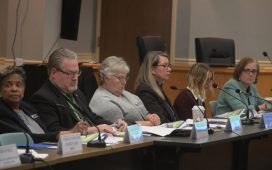When a horse ends up at a rescue or rehoming organization, they’re usually there through no fault of their own. That’s one of several takeaways from an experimental regional support center launched in the Oklahoma City area earlier this year by the American Society for the Prevention of Cruelty to Animals (ASPCA).
Unlike owners of dogs and cats, it’s not easy for all horse owners to find a reputable shelter to take their animals, and many have months-long waiting lists. Some horse owners may delay euthanasia due to high costs of the procedure and subsequent body disposal.
The ASPCA, working with The Right Horse Initiative, wanted to create an open-door surrender location for horse owners who needed to rehome their horses but could not or would not sell them or give them away to private individuals. According to Dr. Emily Weiss, vice president of equine welfare at ASPCA, people could contact the center and schedule a free appointment for a veterinarian to come out and evaluate the horse in need at no cost. If euthanasia was required, that could be provided on the spot, and if the horse could be adopted out, it was placed with a rehoming center in the Right Horse Initiative network.
The ASPCA collected information on each of the owners that contacted the center looking for a safe way to rehome their horses. At last week’s virtual conference of the American Horse Council, Weiss presented data showing that the most common reason for surrendering a horse was the health of the owner, followed closely by personal hardship. A significant portion of owners physically unable to look after their horses cited age as a major factor. Only 9 percent of horses were given up because they didn’t meet the owner’s needs.
Many people who called the regional center for help said they’d been thinking about the decision for months.
“Folks are often thinking for a long time about the need to rehome their horse, and many of them are waiting longer than they necessarily need to,” said Weiss. “There’s some level of fear about what’s going to happen to their horse and they don’t necessarily have confidence about where their horse is going.”
Only 36 percent of the people calling the center said they were concerned about being able to afford board or other horse care expenses. Forty-four percent had owned their horse for more than five years, and 89 percent had owned their horse a year or more. Eighty percent kept their horses on their own property, and 48 percent of callers were aged 60 or older.
Weiss said she wasn’t surprised to hear how few owners said the horse was to blame for its uncertain status.
“We were not surprised to learn such as we had the advantage of seeing the data from the dog and cat sheltering world that shows a similar trend,” she said. “Similar reasons were also the leading factors for relinquishment at the first Regional Support Center pilot, which took place near Dallas in 2018. However, we were surprised to learn the high number of individuals who had to relinquish their horse because they were unable to provide adequate care for the horse due to their age, which is why the ASPCA is committed to raising awareness of horse owners about the need to plan ahead.”
So far, the ASPCA has tested these regional centers in one part of the country and Weiss said it’s possible the statistics around an owner calling for help could be different in other localities. Horsekeeping trends and costs varies widely from one side of the United States to the other. The organization plans to continue studying the issue in the coming years.
The good news for horses “in transition,” as the ASPCA prefers to call them (“unwanted horse” is now a term thought to be a rather poor choice for a horse who must be marketed to a new home) is there’s a lot of demand for trained riding horses right now. In fact, Weiss found that adoption organizations under The Right Horse initiative umbrella have experienced more adoptions this year. Those organizations are reporting a 67 percent increase in foster starts and a 16 percent increase in adoptions in April 2020 as compared to March 2020, with even more coming in May. Some adoption centers have more interested adopters than they do horses for them, and some are even seeing fewer owner surrenders than usual.
“Certainly at the beginning of COVID-19, we had no idea we’d see an increase in adoptions,” said Weiss. “In some ways, COVID has been great – folks are home, this is a safe activity they can do, if not now, when?”
That doesn’t mean there aren’t horses in need out there, of course. Anyone who follows a kill pen bail page on social media knows that riding horses still find themselves in situations where they’re portrayed as at-risk. How do they fit into this picture?
“We have found many challenges as it relates to bail outs,” said Weiss. “Organizations and their supporters often pay significantly more for a horse at time of bail out than they would have if they had acquired the horse before he landed in the pipeline, and those resources that could have been focused on rehabilitation or retraining (or helping additional at-risk horses) are instead spent paying the kill buyer above market price for an equine.
“Horses’ ages, behavior and health are often misrepresented or unknown by the kill buyers posting horses for bail out. While there is a belief by some that bailing out a horse means one fewer horse going to slaughter, we understand that the slaughter truck will leave full whether or not that particular horse is bailed. So, while that one bailed horse is saved, another suffers in his place. We look forward to the end of slaughter when this emotional predation behavior by the kill buyers will be eliminated, but until then we want to help increase awareness of the challenges of bail outs and focus our resources toward other, more sustainable intake options.
“ASPCA safety net services, such as the Regional Support Center, along with our support of other open-admission programs are opening barn doors for individuals unable to keep their horses. By obtaining horses directly from their owners, the full history (behavioral and medical) can be obtained, the horse’s health and behavior can be supported with a quick transition to the rehoming facility and then to a new home. Those that want to save a horse can find their match through adoption by visiting myrighthorse.org. In doing so, adopters are not only finding their next horse, but help create capacity for the adoption organization to support the next horse and their owner in need.”
It’s hard for anyone to predict how the ongoing COVID-19 pandemic could the level of demand from potential adopters or the volume of horses that could eventually need help transitioning between homes, but Weiss said the future for off-track Thoroughbreds (OTTBs) probably looks better than most.
“During any disaster situation, there’s always a risk that horse owners will not be able to provide adequate care for their horses, so it’s important for people, shelters, and communities to prepare for any animal welfare consequences that may result from the COVID-19 crisis,” said Weiss. “That said, the demand for OTTBs has been increasing for several years – in large part thanks to programs such as the Jockey Club TIP program, the Retired Racehorse Project, TAA, TCA and the great work of aftercare groups like New Vocations. The value of these horses has been elevated and riders are actively seeking OTTBs for their next competition horse.”
New to the Paulick Report? Click here to sign up for our daily email newsletter to keep up on this and other stories happening in the Thoroughbred industry.
Copyright © 2020 Paulick Report.








